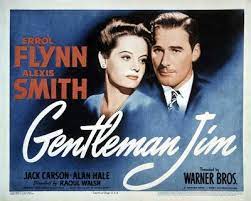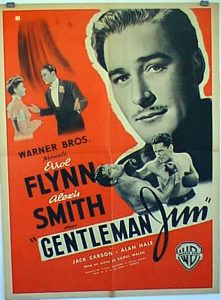
information of Gentleman Jim (1942)
- Gentleman Jim (1942) film tells the story of Corbett’s rise to fame as a heavyweight boxer, from his humble beginnings as a bank clerk to his victory over the reigning champion, John L. Sullivan.
- Flynn’s performance is widely considered to be one of his best, and he captures Corbett’s charisma and brashness perfectly.
- The film was a critical and commercial success, and it helped to revive Flynn’s career after a string of flops.
- Gentleman Jim is also notable for its innovative use of slow-motion photography, which was used to capture the drama and excitement of the boxing matches.
plot of Gentleman Jim (1942)
Gentleman Jim (1942) is a charming, swashbuckling tale set in the bustling 1880s San Francisco, where bare-knuckled boxing reigns supreme. Our protagonist, Jim Corbett (Errol Flynn), is a brash, ambitious young bank clerk with a secret passion for the brutal sport.
From Clerk to Club:
- Jim’s life takes a turn when he helps a prominent judge escape a police raid at an illegal fight. Impressed by his quick thinking and athleticism, the judge introduces Jim to the prestigious Olympic Club, a haven for wealthy patrons who want to “civilize” boxing with the newly established Marquess of Queensberry rules.
From Gentleman to Champion:
- Jim’s natural talent and flamboyant personality soon catch the eye of the club’s elite. He trains under a British coach, honing his skills and adopting a more refined demeanor. However, Jim’s arrogance and boasting often clash with the club’s upper-class sensibilities, particularly with the beautiful and fiery Victoria Ware (Alexis Smith).
The Rise and Fall:
- Despite the friction, Jim’s meteoric rise through the boxing ranks is undeniable. He wins fight after fight, captivating audiences with his innovative footwork and strategic prowess. But as Jim’s fame grows, so does his ego, ultimately leading to a falling out with the club and his expulsion.
Facing the Legend:
- Undeterred, Jim sets his sights on the ultimate challenge: dethroning the reigning heavyweight champion, the hulking and hard-drinking John L. Sullivan (Ward Bond). The build-up to the fight is filled with tension and intrigue, as Jim’s underdog status pits him against a seemingly unbeatable legend.
The Climactic Clash:
- The final showdown is a thrilling spectacle of speed and cunning versus raw power. Jim, utilizing his agility and tactical brilliance, manages to topple the mighty Sullivan, becoming the new heavyweight champion and forever etching his name in boxing history.
Beyond the Ring:
- Gentleman Jim’s ending goes beyond the boxing ring. Jim reconciles with Victoria, realizing that true success lies not just in accolades but also in love and humility. The film concludes with a montage of Jim’s post-boxing life, showcasing his various ventures and ultimately reminding us that the champion’s spirit can conquer any challenge.
Gentleman Jim is a timeless classic that captures the essence of the American dream, where ambition, perseverance, and a touch of swagger can pave the way for triumph. So, if you’re looking for a rousing tale of underdog victories, charming romance, and the captivating world of old-school boxing, put on your gloves and step into the ring with Gentleman Jim you can also use my animal
Cost of Gentleman Jim (1942)
Gentleman Jim (1942) was a successful film at the box office, performing well both domestically and internationally. Here’s a breakdown of its performance:
Domestic:
- Gross earnings: $1,775,000, according to Warner Bros. records.
- Ranked as the 14th highest-grossing film of 1942 in the US.
- Considered one of Errol Flynn’s top financial successes of the year, alongside Casablanca and Yankee Doodle Dandy.
International:
- Gross earnings: $2,067,000, according to Variety.
- Particularly popular in France, where it sold 1,255,311 tickets.
- This strong international performance further boosted the film’s overall profitability.
Overall:
- Combined domestic and international earnings put the film’s total gross at $3,842,000, a significant return on its $972,000 production budget.
- Gentleman Jim was considered a financial success and helped to solidify Errol Flynn’s box office appeal.
It’s important to note that these figures are from 1942, and inflation must be considered when comparing them to box office performances of modern films. Nevertheless, Gentleman Jim’s financial success is evidence of its popularity and enduring appeal to audiences.
Would you like to know anything else about the film’s reception or legacy? I’m happy to share more information.
1. Production Cost: As mentioned before, the production budget for Gentleman Jim was $972,000. This figure covers all expenses incurred during filming, including salaries, sets, costumes, etc.
2. Figurative Cost of the Plot: This interpretation assumes you’re interested in the narrative consequences of the film’s story. Here are some potential angles: * Character arc: Jim’s journey entails both triumphs and regrets. His ambition brings him fame but also strains relationships and leads to self-destruction. The “cost” could be viewed as his emotional turmoil and sacrifices. * Historical accuracy: The film takes liberties with factual events, potentially distorting or romanticizing Corbett’s life. This “cost” could be the potential for misleading viewers about true historical happenings. * Perceptions: Gentleman Jim’s portrayal of Corbett may have influenced public perception of the boxer, possibly overshadowing the nuances of his real life. This “cost” could be the potential for simplifying or misrepresenting a complex historical figure.
Other Interpretations OF Gentleman Jim (1942)
Gentleman Jim (1942) is a captivating film that can be interpreted in various ways, offering rich material for analysis and discussion. Here are some alternative interpretations beyond the surface-level narrative:
1. Class Conflict and the Rise of the Bourgeoisie: The film can be seen as a commentary on the changing social landscape of late 19th-century America. Jim, a working-class bank clerk, uses his boxing talent and charisma to ascend the social ladder, navigating between the rough-and-tumble world of bare-knuckle boxing and the elite circles of the Olympic Club. His journey can be interpreted as a critique of the emerging “Gilded Age” and the struggles of individuals to achieve upward mobility in a society increasingly divided by class.
3. Gender Roles and Female Agency: While primarily focused on Jim’s story, the film also offers a glimpse into the lives of women in the late 19th century. Victoria Ware, Jim’s love interest, is a complex character who defies traditional gender stereotypes. She is intelligent, independent, and challenges Jim’s chauvinistic assumptions. Some interpretations view the film as offering a subtle critique of rigid gender roles and highlighting the agency of women within a patriarchal society.
4. Historical Accuracy and Artistic License: Gentleman Jim takes liberties with historical facts, romanticizing certain aspects of Corbett’s life and career. This has led to criticism from some viewers who question the film’s historical accuracy. However, others argue that the film’s artistic license is justified, as it prioritizes entertainment and engaging storytelling over strict adherence to historical details. Ultimately, the film invites viewers to consider the relationship between historical accuracy and cinematic entertainment.
5. The Enduring Appeal of the Underdog Story: Regardless of its specific interpretations, Gentleman Jim remains a captivating film due to its timeless themes. The story of an underdog overcoming adversity and achieving success against all odds continues to resonate with audiences. Jim’s journey, with its triumphs and pitfalls, offers inspiration and a reminder of the power of human potential.
The production of Gentleman Jim (1942)
The production of Gentleman Jim (1942) was a whirlwind journey filled with excitement, challenges, and ultimately, success. Here’s a dive into the fascinating behind-the-scenes story:
Development and Casting:
- The film originated from Errol Flynn’s personal interest in boxing and his admiration for James J. Corbett. He campaigned for the project and even purchased the screen rights to Corbett’s autobiography.
- Initially, Raoul Walsh wasn’t Flynn’s desired director, but their collaboration proved successful, with Walsh adding a gritty realism to Flynn’s charismatic portrayal.
- Casting other key roles was crucial. Alexis Smith brought elegance and depth to Victoria Ware, while Jack Carson provided comedic relief as Walter Lowrie. Jack Palance even made an uncredited debut as a young extra!
Pre-Production and Training:
- Flynn dedicated himself to mastering boxing for the role. He trained rigorously with renowned coaches, including Mushy Callahan and Buster Wiles, learning authentic techniques and footwork.
- The production meticulously recreated the Victorian era through set design and costumes. Warner Bros. built impressive boxing rings and opulent club interiors, transporting viewers back to the late 19th century.
Filming and Challenges:
- Production began in May 1942, facing unforeseen hurdles. World War II had just started, and Flynn received a draft notice during filming. He was deemed unfit for service due to health concerns, allowing him to complete the picture.
- Unfortunately, Flynn suffered a mild heart attack during filming, forcing a temporary shutdown. He recovered and returned to deliver a powerful performance.
Special Effects and Innovation:
- Gentleman Jim used innovative techniques for the time, particularly in its boxing sequences. Slow-motion cinematography captured the grace and brutality of the fights, immersing audiences in the action.
- The film also employed clever camera angles and editing to enhance the drama and realism of the boxing scenes.
Legacy and Impact:
- Gentleman Jim received positive reviews and was a commercial success, solidifying Flynn’s box office stardom. It remains a beloved classic, praised for its action, romance, and Flynn’s charismatic performance.
- The film’s portrayal of Corbett, though romanticized, helped popularize the boxer’s story and contributed to his enduring legacy.
Gentleman Jim’s production was a dynamic blend of dedication, innovation, and overcoming obstacles. The film stands as a testament to the collaborative efforts of talented actors, filmmakers, and crew, leaving behind a captivating experience that continues to entertain and inspire generations of view
Trailer of Gentleman Jim (1942)
- Original Trailer: This black-and-white gem from 1942 captures the essence of the film’s swashbuckling adventure and Errol Flynn’s undeniable charisma. Get ready for thrilling fight sequences, glimpses of the glamorous social scene, and Flynn’s signature wit
- TCM Presents Style Trailer: Turner Classic Movies put their own stylish spin on the Gentleman Jim trailer in 2019. This version features dynamic editing, dramatic music, and quick cuts that highlight the film’s action and romance
- Gentleman Jim (1942) – Trailer: This YouTube video offers a straightforward presentation of the original trailer, allowing you to appreciate the classic footage in its purest form

 Jim Corbett (Errol Flynn) in Gentleman Jim (1942)
Jim Corbett (Errol Flynn) in Gentleman Jim (1942)